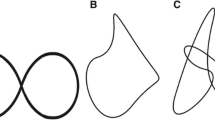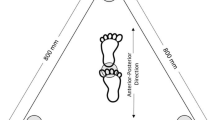Abstract
Impaired postural control has been reported in patients with chronic neck pain of both traumatic and non-traumatic etiologies, but whether painful stimulation of neck muscle per se can affect balance control during quiet standing in humans remains unclear. The purpose of the present experiment was thus to investigate the effect of experimental neck muscle pain on standing balance in young healthy adults. To achieve this goal, 16 male university students were asked to stand upright as still as possible on a force platform with their eyes closed in two conditions of No pain and Pain of the neck muscles elicited by experimental painful electrical stimulation. Postural control and postural performance were assessed by the displacements of the center of foot pressure (CoP) and of the center of mass (CoM), respectively. The results showed increased CoP and CoM displacements variance, range, mean velocity, and mean and median frequencies in the Pain relative to the No pain condition. The present findings emphasize the destabilizing effect of experimental neck muscle pain per se, and more largely stress the importance of intact neck neuromuscular function on standing balance.


Similar content being viewed by others
References
Alund M, Ledin T, Odkvist L, Larsson SE (1993) Dynamic posturography among patients with common neck disorders. A study of 15 cases with suspected cervical vertigo. J Vestib Res 3:383–389
Bennell KL, Hinman RS (2005) Effect of experimentally induced knee pain on standing balance in healthy older individuals. Rheumatology 44:378–381
Bennell K, Wee E, Crossley K, Stillman B, Hodges P (2005) Effects of experimentally-induced anterior knee pain on knee joint position sense in healthy individuals. J Orthopaedic Res 23:46–53
Blouin JS, Corbeil P, Teasdale N (2003) Postural stability is altered by the stimulation of pain but not warm receptors in humans. BMC Musculoskelet Disord 17:4–23
Brandt T, Bronstein AM (2001) Cervical vertigo. J Neurol Neurosurg Psychiatry 71:8–12
Brenière Y (1996) Why we walk the way we do? J Mot Behav 28:291–298
Brown LA, Polych MA, Doan JB (2006) The effect of anxiety on the regulation of upright standing among younger and older adults. Gait Posture 24:397–405
Caron O, Faure B, Brenière Y (1997) Estimating the center of gravity of the body on the basis of the center of pressure in standing posture. J Biomech 30:1169–1171
Carpenter MG, Frank JS, Silcher CP (1999) Surface height effects on postural control: a hypothesis for a stiffness strategy for stance. J Vestib Res 9:277–286
Carpenter MG, Frank JS, Silcher CP, Peysar GW (2001) The influence of postural threat on the control of upright stance. Exp Brain Res 138:210–218
Corbeil P, Blouin JS, Teasdale N (2004) Effects of intensity and locus of painful stimulation on postural stability. Pain 108:43–50
Crombez G, Eccleston C, Baeyens F, Eelen P (1996) The disruptive nature of pain: an experimental investigation. Behav Res Ther 34:911–918
Dehner C, Heym B, Maier D, Sander S, Arand M, Elbel M, Hartwig E, Kramer M (2008) Postural control deficit in acute QTF grade II whiplash injuries. Gait Posture 28:113–119
Eccleston C, Crombez G (1999) Pain demands attention: a cognitive-affective model of the interuptive function of pain. Psychol Bull 25:356–366
Ehrenfried T, Guerraz M, Thilo KV, Yardley L, Gresty MA (2003) Posture and mental task performance when viewing a moving visual field. Cogn Brain Res 17:140–153
Gage WH, Winter DA, Frank JS, Adkin AL (2004) Kinematic and kinetic validity of the inverted pendulum model in quiet standing. Gait Posture 19:124–132
Gosselin G, Rassoulian H, Brown I (2004) Effects of neck extensor muscles fatigue on balance. Clin Biomech 19:473–479
Gregoric M, Tayeka T, Baron JB, Bessineton JC (1978) Influence of vibration of neck muscles on balance control in man. Agressologie 19:37–38
Heikkilä H, Aström PG (1996) Cervicocephalic kinesthetic sensibility in patients with whiphlash injury. Scand J Rehabil Med 28:133–138
Hunter MC, Hoffman MA (2001) Postural control: visual, cognitive manipulations. Gait Posture 13:41–48
Karlberg M, Persson L, Magnusson M (1995) Reduced postural control in patients with chronic cervicobrachial pain syndrome. Gait Posture 3:241–249
Koskimies K, Sutinen P, Aalto H, Starck J, Toppila E, Hirvonen T, Kaksonen R, Ishizaki H, Alaranta H, Pyykko I (1997) Postural stability, neck proprioception and tension neck. Acta Otolaryngol Suppl 529:95–97
Kristjansson E, Dall’Alba P, Jull G (2003) A study of five cervicocephalic relocation tests in three different subject groups. Clin Rehabil 17:768–774
Latash ML, Anson JG (1996) What are normal movements in atypical populations? Behav Brain Sci 19:55–106
Ledebt A, Brenieère Y (1994) Dynamical implication of anatomical and mechanical parameters in gait initiation process in children. Hum Mov Sci 13:801–815
Madeleine P, Lundager B, Voigt M, Arendt-Nielsen L (1999) Shoulder muscle co-ordination during chronic and acute experimental neck-shoulder pain. An occupational pain study. Eur J Appl Physiol 79:127–140
Madeleine P, Prietzel H, Svarrer H, Arendt-Nielsen L (2004) Quantitative posturography in altered sensory conditions—A way to assess balance instability in patients with chronic whiplash injury. Arch Phys Med Rehabil 85:432–438
Maki BE, McIlroy WE (1996) Influence of arousal and attention on the control of postural sway. J Vestib Res 6:53–59
Massion J (1994) Postural control system. Curr Opin Neurobiol 4:877–887
Matre DA, Arendt-Nielsen L, Knardahl S (2002) Effects of localization and intensity of experimental muscle pain on ankle joint proprioception. Eur J Pain 6:245–260
Michaelson P, Michaelson M, Jaric S, Latash ML, Sjolander P, Djupsjobacka M (2003) Vertical posture and head stability in patients with chronic neck pain. J Rehabil Med 35:229–235
Persson L, Karlberg M, Magnusson M (1996) Effects of different treatments on postural performance in patients with cervical root compression. A randomized prospective study assessing the importance of the neck in postural control. J Vestib Res 6:439–453
Pinsault N, Vuillerme N, Pavan P (2008) Cervicocephalic relocation test to the neutral head position assessment in bilateral labyrinthine-defective and chronic, nontraumatic neck pain patients. Arch Phys Med Rehabil (in press)
Poole E, Treleaven J, Jull G (2008) The influence of neck pain on balance and gait parameters in community-dwelling elders. Man Ther 13:317–324
Price DD, McGrath PA, Rafii A, Buckingham B (1983) The validation of visual analogue scales as ratio scale measures for chronic and experimental pain. Pain 17:45–56
Redfern MS, Yardley L, Bronstein AM (2001) Visual influences on balance. J Anxiety Disord 15:81–94
Revel M, Andre-Deshays C, Minguet M (1991) Cervicocephalic kinesthetic sensibility in patients with cervical pain. Arch Phys Med Rehabil 72:288–291
Riley MA, Baker AA, Schmit JM (2003) Inverse relation between postural variability and difficulty of a concurrent short-term memory task. Brain Res Bull 62:191–195
Roll JP, Roll R (1988) From eye to foot. A proprioceptive chain involved in postural control. In: Amblard B, Berthoz A, Clarac F (eds) Posture and Gait. Elsevier, Amsterdam, pp 155–164
Schieppati M, Nardone A, Schmid M (2003) Neck muscle fatigue affects postural control in man. Neuroscience 121:277–285
Svensson P, Arendt-Nielsen L (1995) Induction and assessment of experimental muscle pain. J Electromyogr Kinesiol 5:131–140
Swan L, Otani H, Loubert PV (2007) Reducing postural sway by manipulating the difficulty levels of a cognitive task and a balance task. Gait Posture 26:470–474
Treleaven J, Jull G, Sterling M (2003) Dizziness and unsteadiness following whiplash injury: characteristic features and relationship with cervical joint position error. J Rehabil Med 35:36–43
Treleaven J, Murison R, Jull G, LowChoy N, Brauer S (2005) Is the method of signal analysis and test selection important for measuring standing balance in subjects with persistent whiplash? Gait Posture 21:395–402
Vuillerme N, Vincent H (2006) How performing a mental arithmetic task modifies the regulation of centre of pressure displacements during quiet standing. Exp Brain Res 166:130–134
Vuillerme N, Nougier V, Teasdale N (2000) Effects of a reaction time task on postural control in humans. Neurosci Lett 291:77–80
Vuillerme N, Marin L, Debû B (2001) Assessment of static postural control in teenagers with Down Syndrome. Adapt Phys Activ Q 18:417–433
Vuillerme N, Pinsault N, Vaillant J (2005) Postural control during quiet standing following cervical muscular fatigue: effects of changes in sensory inputs. Neurosci Lett 378:135–139
Weerakkody NS, Blouin JS, Taylor JL, Gandevia SC (2008) Local subcutaneous and muscle pain impairs detection of passive movements at the human thumb. J Physiol 586:3183–3193
Winter DA (1995) Human balance and posture control during standing and walking. Gait Posture 5:193–214
Zok M, Mazzà C, Cappozzo A (2008) Should the instructions issued to the subject in traditional static posturography be standardised? Med Eng Phys 30:913–916
Acknowledgments
The authors would like to thank the subject volunteers and the anonymous reviewers for their valuable comments and suggestions on the first version of the manuscript.
Author information
Authors and Affiliations
Corresponding author
Rights and permissions
About this article
Cite this article
Vuillerme, N., Pinsault, N. Experimental neck muscle pain impairs standing balance in humans. Exp Brain Res 192, 723–729 (2009). https://doi.org/10.1007/s00221-008-1639-7
Received:
Accepted:
Published:
Issue Date:
DOI: https://doi.org/10.1007/s00221-008-1639-7




